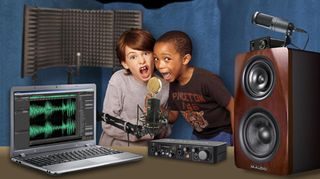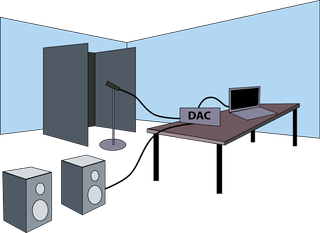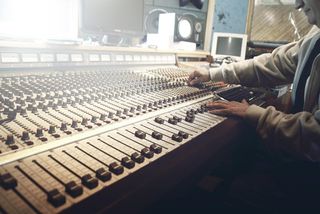How to build an affordable recording studio
Your web and media projects need audio. Lance Evans takes you through the basics of building an in-house studio.

As the web and other projects become increasingly high-def multimedia based, great quality audio is a component we all must embrace. This is true with high end work, but even budget web promotions and client presentations become more alive with the addition of good quality narration, sound effects and music.
Many shops think audio is either too hard to do in-house and send it out. Or by contrast that it is so easy they can throw it off to the new intern to do at his cubicle. While both extremes can be true, many day-to-day projects fall somewhere in between.
This article will teach you how to build a basic, but high quality in-house audio recording studio. And while it will record sound effects and music, its main goal is to record the human voice for narration, voice overs, client presentations, and various speaking parts in web/radio/tv commercials.
Understanding the basic audio studio
The entry level recording studio has gotten very accessible over the years, both in price and complexity. The basic audio recording pipeline is:
- Source of sound (actor, singer, musical instruments, sound effects, environments)
- Microphone, with cable and stand
- DAC (Digital Analog Converter, analog > digital path)
- Computer (desktop or laptop)
- Recording software (see our article on recording software)
We also need to hear what we've recorded. So a basic playback pipeline is:
- Computer
- Your audio software used for playback
- DAC (this time from digital > analog)
- An audio amplifier (often built into 'active' speakers)
- Speakers (often referred to as "monitors" in the recording world)
These aren't long lists, and you already have many of the items. You certainly have a computer, software can be anything from the free Audacity program on up. You might also have a stereo and speakers from your pre-smartphone days. You also have a mic in your laptop, webcam and headset, but this should get upgraded fast.
You even have a DAC: your computer's sound card! This is fine for playback, but you will want an external unit for recording that offers more functionality.
Get the Creative Bloq Newsletter
Daily design news, reviews, how-tos and more, as picked by the editors.
Determining needs and space
As a voice recording studio, we need enough room to hold the 'talent', the engineer, and a modest amount of hardware. If you're recording your own voice, it could be done in your cubicle. If properly prepared, and if your noisy cubicle neighbours hold it down.
A better option is to seek out an extra small office, or a conference room where you can set up and break down as needed. As a home studio, basements, garages, extra bedrooms and even walk-in closets work well. Bonus: clothing in a closet can create a good acoustically 'dead' room!
Choose your weapons

Choosing the hardware to build a studio with can be daunting. Our goals: solid working gear at affordable prices. We looked at, and used, a range of items from top vendors, and share our favorites.
Sound baffling the studio
Sound 'proofing' a room is expensive and reserved for pro studios. But sound 'conditioning' is the treatment of a recording space to remove/lessen as much unwanted sound as possible. Culprits include echo and reverberation, and low-end bass resonances. The goal is a room with a 'dead' sound. Because while we can add room ambiance later in software, we can't remove it if it's in the recording.
Pro acoustic panels can cost a fortune. So my favorite alternative-on-the-cheap is to use 72x80-inch moving blankets as baffle material. These can be purchased online in packages for as little as $15US per blanket. Great in the studio, or on location.
An even better solution is a blanket made specifically for sound deadening called Producer's Choice. These are 80x96-inch, a heavy 11 pounds to absorb sounds, and up to 80 per cent effective if used correctly. $39 each, or six for $214US.
Basic blanket set up is easy: we used four lightstands (Adorama's Flashpoint FPL-S7) and attached a cross-pole (metal or PVC conduit from a hardware store). Drape a blanket and secure with spring clamps.
Stuck recording in your cubicle? Try the very affordable Microphone Isolation Shield from Monoprice.
Mics
The end-goal on mic selection is to find one that makes the performer's voice sound good. Popular brands include Audio-Technica, Sennheiser and Shure.
Quality mics can cost thousands. Being budget conscious we tried out Monoprice's new Lollipop-Style Large Diaphragm Condenser Microphone.
Large diaphragm mics are traditionally desirable for smooth voices. This mic comes at a great price-point for such a design ($299US). In our testing the Lollipop delivered on sound quality, and came with a nice shock-mount suspension system, and carry case. As with most pro mics, it requires 'phantom power', which leads us right into to the next topic.
DACs, mixing boards and other IN/OUTs
Traditional studios use mixing boards for recording, but most of that power is found in your recording software today. You'll still need a way to connect your mic's XLR or TRS cables, something your standard audio card doesn't offer.
An easy to use solution is M-Audio's M-Track Plus Mark II. This affordable 2-channel USB computer interface offers high quality, all your IN/OUT ports, and 'phantom' power for mics.
The M-Track comes with working lite versions of Ableton Live and Cubase. Powerful software, with an upgrade path to the full versions.

Your playback system
Hearing your tracks play back is a great feeling, but the hardware you choose will be important. A good set of headphones will always offer the best bang for the buck, but plan on getting some studio speakers.
What kind of playback system do you want? Is stereo enough? Do you want 5.1 surround sound? Surround 'home theater' audio is increasingly popular, supported by almost all audio software, and the format most movies, TV and even games are produced in today. Many conference rooms are set up for it too, making it viable for quality presentations.
We looked at three options: Low-to-moderate cost traditional stereo amp and speakers, two great self-powered stereo speaker options, and one surround sound amp/speaker system.
Amp/Speakers
Setting up a traditional amp and speakers offers the widest selection, and great deals. For example, we found the popular SMSL SM-50 amplifier which kicks out 50 watts/channel and sells for just $66US online! It's well built with a metal case, and had enough power to drive a pair of medium bookshelf speakers to fill a 20x20-foot room.
If you have an audiophile bent, the same distributor also sells the GemTune tube amps. Tube amps are considered the best, particularly with vocals and acoustics. Their X-1 class-A tube amp impressed everyone and is a steal for a tube amp at the current $299US. Tubes have less output power, but studio monitors are used 'near field', meaning close, so this is no issue.
Self-powered studio monitors
Studio speakers with built-in amplifiers have become semi-standard today. There are some pluses and minuses, but it's really just a matter of preference.
We looked at two great powered monitors. On the high-end we sampled M-Audio's very unique M3-6. It's one of the best looking speakers we've seen.
Beyond looks, it's a heavy and well built large bookshelf unit that has a very unusual three-way driver system. The tweeter is actually stacked atop the midrange driver. Three drivers offer a smoother sound, with a crisp high end, neutral midrange, and a low end that reaches deeper with its 6-inch Kevlar woofer.
The sound was so good, I was able to actually hear the compression on steaming music, forcing me to switch streaming services! With a current street price of under $500 for a pair, this is awesome top quality bang for the buck. A larger version, the M3-8 has an 8-inch woofer.
The other monitor system we looked at came from KRK, a company that has almost taken over the studio monitor market with their wonderful VXT and Expose speakers. We looked at their low-cost ROKIT line's ROKIT 5 (generation 3), with a street price of under $300 a pair.
Sporting KRK's signature yellow glass-Aramid composite woofer, this modest 5-inch bass driver and dome tweeter are housed in a compact 9x7x11-inch case, weighing just 16 lbs. The sound from it was crisp on the high end, with a controlled punch on the lower end. This is a wonderful choice for entry level speakers, or any small/home studio.
While both speakers had great bass for their size, neither reached down to the bass floor the way a subwoofer can. So we took a look at the Monoprice's 10 Powered Studio Subwoofer. With its built-in 200 watt amplifier (peaking at over 400 watts), it was easily able to rattle the window panes with its tight bass. It filled in the low end wonderfully. While you are unlikely to be recording voice-overs in this range, sound effects, stock music and music you create on computer could all contain these low frequencies.
Surround sound
The effect of engulfing the listener in a full audio environment is awesome. If your working in your cubicle, you can set up your own 5.1 playback with Logitech's great low and medium-end solutions.
Higher end 5.1 playback systems can be more costly as you need six speakers that include: two front, a centre, two rear, and a subwoofer. Plus an amplifier that supports 5.1.
We found a way to get a great sounding 5.1 playback system for well under $1,000US. Yamaha, a leader in high quality amps, just released a new line that includes their RX-V379 for under $280. Great sound, and more controls than your studio will ever need. Higher units in the series have even more power and options.
For a speakers we found one of the best sleeper deals in audio, from BIC America. In business since 1973, they make great sounding affordable speakers. We tested their most popular bookshelf, the DV62si for the front and back, their widely acclaimed DV62CLR-S center speaker, and their self-powered Venturi V1220 200 watt subwoofer.
All of those speakers have a great sound, and a solid 'furniture' style build. And can be had from Amazon.com for under $600US for all! This serious surround system was far too powerful for the 20x20-foot testing space, and gave a real theater sound.
Summary
Audio is important part of our work, and increasingly important for web projects. By tapping into the affordable high-quality tools available today, anyone can afford to set up a home, or entry-level corporate recording studio. Tell us about your studio, and share your tips in the comments.
Words: Lance Evans
Lance Evans is creative director of Graphlink Media.
Like this? Read these...
- How to build an app: try these great tutorials
- Free graphic design software available to you right now!
- Brilliant Wordpress tutorial selection

Thank you for reading 5 articles this month* Join now for unlimited access
Enjoy your first month for just £1 / $1 / €1
*Read 5 free articles per month without a subscription

Join now for unlimited access
Try first month for just £1 / $1 / €1
The Creative Bloq team is made up of a group of design fans, and has changed and evolved since Creative Bloq began back in 2012. The current website team consists of eight full-time members of staff: Editor Georgia Coggan, Deputy Editor Rosie Hilder, Ecommerce Editor Beren Neale, Senior News Editor Daniel Piper, Editor, Digital Art and 3D Ian Dean, Tech Reviews Editor Erlingur Einarsson and Ecommerce Writer Beth Nicholls and Staff Writer Natalie Fear, as well as a roster of freelancers from around the world. The 3D World and ImagineFX magazine teams also pitch in, ensuring that content from 3D World and ImagineFX is represented on Creative Bloq.
